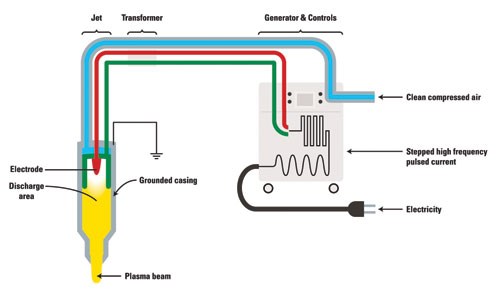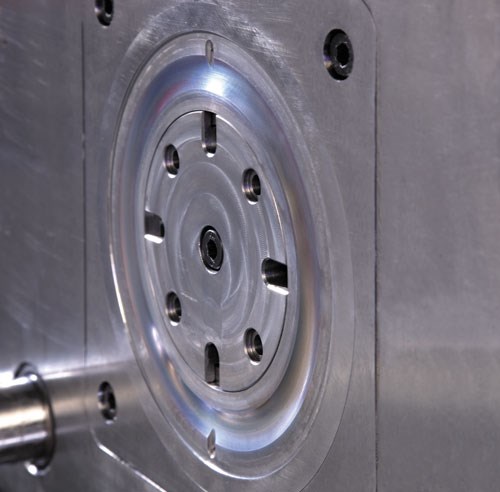Process Produces Anti-Adhesion Coating Directly in the Mold
A new plasma coating displaces chemical release agents or durable coatings in injection molding and regenerates inside the mold.
By nature polyurethane (PUR) foams like to stick to a steel mold. A new plasma coating has made it not only possible to displace chemical release agents or durable coatings in the injection molding process of polyurethanes, elastomers and thermoplastics, but also to regenerate itself inside the mold.
PUR foam processing is traditionally linked with the use of wet chemical release agents that are sprayed into the mold. This is usually done after the production of a defined number of workpieces where a lot size of 1 (e.g., repeated spraying after having produced one single workpiece only) is nothing unusual. Disadvantages of this process are the contamination of other mold areas with what is known as overspray—a spray mist escaping to the environment.—on the one hand and the increased maintenance effort on the other, since the molds require cleaning at regular intervals. The demolded workpieces are then left mostly with traces of the release agents, which can lead to considerable difficulties in subsequent processes.
Another technique facilitating the demolding of PUR foam is the application of durable mold coatings that are applied to the inserts of the injection mold. In doing so, the inserts must first be removed and then sent to a company specialized in such coatings. After the removal of the old coat and the deposit of the new one, the insert must be mounted into the machine again.
It is true that the resulting releasing effect is given for an extended period of time, but sooner or later the coatings wear off and need to be renewed. In order to avoid prolonged downtime, not just one but several mold inserts are needed for replacing them in line with the requirements. However, these mold inserts cannot be recoated as often as desired since they are subject to wear when the firmly adhering coatings are removed—a costly and time-intensive process.
Process Basics and Benefits
There is now a process1 that allows for production of an anti-adhesion coating directly in the mold without the known disadvantages. This anti-adhesion solution works by plasma-polymerization only, a new inline technology which allows the release agent-free processing of PUR, TPE and TPU (Figure 1).
The basis of the new process is an atmospheric plasma surface pre-treatment technique (Figure 2), which was developed and patented in 1995. This zero-potential plasma system is characterized by a three-fold action: (1) it activates surfaces by selective oxidation processes; (2) discharges them at the same time and (3) brings about microfine cleaning and high activation of metal, plastic, ceramic and glass surfaces.
The range of different nozzles allows even complex geometries to be treated. The activation effect makes surface energies of over 72 mJ/m2 possible for most plastics, which means the invisible modification of the oxide structure of the surface—which takes place here—creates optimal conditions for reliable bondings or coatings. The plasma hits the surface at almost ultrasonic speed and the beam’s intensity is so high that treatment rates of several 100 m/min can be achieved.
Until recently plasma coating used to be a process that could only be carried out in vacuum. Now a new process allows for nanoscale thin films to be applied to the surfaces of materials at atmospheric pressure1.
With these coatings, anticorrosive effects can be achieved, adhesion promoter properties created or, as further development proved, excellent release functions provided. The latter is a completely new method which allows, for the first time, the release-agent-free processing of plastic materials through coating and regeneration in the injection molding tool itself. The anti-adhesion effect is solely generated by plasma polymerization on the surface of the molding tool.
The coating process is integrated in the normal operating cycle of the workflow, so that the anti-adhesion coating is applied to the mold after the production of a defined number of workpieces. The produced release coating is only a few nanometers thick and therefore has no effect on the dimensional accuracy of the workpiece (Figure 3). Intervention is automated and independent of the operating staff. It only takes a few seconds depending upon the geometry of the area to be treated.
This coating is a silicone-free, universally applicable mold release agent with excellent sliding properties that is capable of effectively preventing accretions of the most varied materials—such as polyurethane foams, polyester and epoxy resins, etc.—in the injection mold. The release coating is to be applied at places where silicones are undesirable or where post-treatment of the surfaces of the injection molded parts is necessary. There are no disturbing release agent remainders left on the injection molded parts, so they can be subjected to painting, printing, metallizing or bonding immediately after demolding with no need for previous cleaning of the surfaces of these parts.
Wet-chemical release agents are completely substituted by this process, and there is also no longer need for demounting the mold for re-coating purposes since worn-off coatings do not have to be removed anymore. Within a few minutes, the plasma release coating can be regularly regenerated fully automatically in the injection mold itself after a defined number of demolding processes—thus totally eliminating manual application.
Summary
The plasma process described can be considered a trailblazing new technology in injection molding since it can lead to a much higher efficiency in the work flow. Another one of its advantages is its environmental friendliness, given that the operating gases and monomers are non-toxic and the nanocoating is completely free of hazardous substances. There is no need for disposal or treatment of chemicals. The system exhibits high process reliability in practical use and can easily be integrated into any new or existing automated production line.
References
1A new anti-adhesion solution that works by plasma-polymerization from Plasmatreat, atmospheric plasma technology-using nozzle-systems supplier, and its system partner CeraCon, an international engineering specialist for foam sealing systems. In close collaboration with the renowned Research Institute Fraunhofer IFAM in Bremen, Germany, Plasmatreat developed the PlasmaPlus process, which was brought to industrial application in 2007 by coating engine pump housings for steering units against bondline corrosion at TRW Automotive.
2Openair plasma surface pre-treatment technique by Plasmatreat.
Related Content
Questions and Considerations Before Sending Your Mold Out for Service
Communication is essential for proper polishing, hot runner manifold cleaning, mold repair, laser engraving and laser welding services.
Read MoreLine Width vs. Depth Ratio in Laser Engraving
A laser does not produce 90-degree sidewalls. It requires a certain amount of draft in order to produce the required pattern.
Read MoreLaser Welding Versus Micro Welding
The latest battle in finely detailed restoration/repair of mold materials.
Read MoreHow to Overcome Complex Mold Texturing Problems
Key benefits when considering laser technology for mold texturing and repair.
Read MoreRead Next
How to Use Strategic Planning Tools, Data to Manage the Human Side of Business
Q&A with Marion Wells, MMT EAB member and founder of Human Asset Management.
Read MoreHow to Use Continuing Education to Remain Competitive in Moldmaking
Continued training helps moldmakers make tooling decisions and properly use the latest cutting tool to efficiently machine high-quality molds.
Read More




















